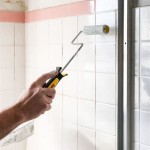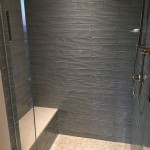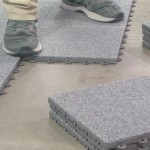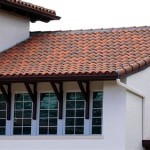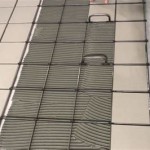How to Install Vinyl Plank Flooring Over Ceramic Tile
Installing vinyl plank flooring over existing ceramic tile represents a practical and cost-effective way to update a space without the extensive and messy demolition typically associated with flooring replacement. By opting to install vinyl plank directly on top of the tile, homeowners can avoid the labor, dust, and disposal fees related to removing the existing ceramic. This method, however, requires careful preparation and adherence to specific guidelines to ensure a successful and long-lasting result.
The primary advantage of this installation approach lies in its ability to save time and reduce overall project costs. Tearing up ceramic tile is a physically demanding task often requiring specialized tools and protective equipment. Furthermore, the process generates a significant amount of debris that must be properly disposed of. Installing vinyl plank over tile eliminates these concerns, making it an appealing option for both DIY enthusiasts and those seeking to minimize professional labor expenses. Before beginning any undertaking, a thorough evaluation of the existing tile and subfloor is crucial. Any significant imperfections or structural deficiencies must be addressed to prevent future problems with the vinyl plank flooring.
Assessing the Existing Ceramic Tile
The initial step in installing vinyl plank flooring over ceramic tile involves a comprehensive assessment of the existing surface. This assessment focuses primarily on identifying any potential issues that could compromise the integrity of the new flooring. The ceramic tile should be thoroughly inspected for cracks, loose tiles, and uneven surfaces. Small cracks may be repairable, but widespread cracking often indicates a more significant underlying problem, such as subfloor instability. Loose tiles should be carefully removed and the area properly filled to create a level surface. Any significant height variations between tiles can create an uneven surface that will eventually telegraph through the vinyl plank, resulting in an aesthetically unappealing floor and potential damage to the vinyl planks themselves.
The flatness of the existing tile floor is paramount. While some minor imperfections are acceptable, significant undulations or dips will need to be addressed. A long level or straight edge, at least 6 feet in length, can be used to identify these uneven areas. Place the level across various sections of the floor and look for gaps underneath. Areas with gaps exceeding 1/8 inch will likely require patching or leveling. Self-leveling compound is typically the preferred method for correcting these imperfections, creating a smooth and even surface for the vinyl plank installation. The state of the grout lines also needs consideration. Deep or wide grout lines can create a similar telegraphing effect as uneven tiles. The grout lines should be filled with a cement-based patching compound to create a flush surface with the surrounding tiles. Failure to adequately address these initial preparation steps can lead to premature wear and tear on the vinyl plank flooring and a less-than-desirable finished appearance.
Moisture is another critical factor to consider. Ceramic tile is inherently waterproof, but moisture can still be a problem if the subfloor beneath the tile is not properly sealed. If there is any suspicion of moisture issues, a moisture test should be conducted. This can be done using a moisture meter or by taping a plastic sheet to the floor for a period of 24-48 hours. If condensation forms under the plastic, it indicates that moisture is present. In such cases, it is imperative to identify and address the source of the moisture before proceeding with the vinyl plank installation. Installing vinyl plank over a damp surface can lead to mold growth, adhesive failure, and eventual deterioration of the flooring.
Preparing the Ceramic Tile Surface
Once the assessment of the existing tile floor is completed, the next step involves preparing the surface to ensure proper adhesion and a smooth, level substrate for the vinyl plank flooring. This preparation typically involves thorough cleaning, patching uneven areas, and applying a primer.
The initial cleaning process is essential to remove any dirt, dust, grease, or other contaminants that could interfere with the adhesion of the vinyl plank flooring. Start by sweeping or vacuuming the entire floor to remove loose debris. Following this, scrub the floor thoroughly with a solution of water and a TSP (trisodium phosphate) cleaner or a similar degreasing agent. This will help to remove any stubborn dirt or grease that may be present. After scrubbing, rinse the floor thoroughly with clean water to remove all traces of the cleaning solution. Allow the floor to dry completely before proceeding to the next step. The cleanliness of the surface directly impacts the bond between the tile and the adhesive used for the vinyl plank flooring. A clean, dry surface ensures optimal adhesion and a longer lifespan for the installed floor.
As previously mentioned, addressing uneven areas is crucial. Use a cement-based patching compound to fill in any cracks, chips, or voids in the ceramic tile. Apply the patching compound according to the manufacturer's instructions, ensuring that it is level with the surrounding tile surface. For deeper grout lines, apply a thin layer of the patching compound to fill them in completely. Allow the patching compound to dry completely before sanding it smooth. Sanding will help to blend the patched areas seamlessly with the existing tile, creating a perfectly level surface. For larger areas of unevenness, self-leveling compound may be required. Self-leveling compound is a pourable liquid that spreads easily and hardens to create a perfectly flat surface. Follow the manufacturer's instructions carefully when applying self-leveling compound, as it can be tricky to work with. It is important to ensure that the compound is properly mixed and that the floor is properly prepared before pouring it.
The final step in preparing the surface is to apply a primer. A primer is a liquid that is applied to the tile surface to improve the adhesion of the vinyl plank flooring adhesive. Choose a primer that is specifically designed for use with vinyl flooring and follow the manufacturer's instructions for application. The primer will help to create a strong bond between the tile and the vinyl plank, ensuring that the flooring stays in place for years to come. It also helps to seal the surface, preventing moisture from penetrating the tile and damaging the subfloor. Priming is a relatively inexpensive step that can significantly improve the performance and longevity of the vinyl plank flooring, especially when installing over ceramic tiles.
Installing the Vinyl Plank Flooring
With the ceramic tile surface properly prepared, the final stage involves the actual installation of the vinyl plank flooring. This process requires careful planning, precise measurements, and attention to detail to ensure a professional-looking and durable result.
Before beginning the installation, it is essential to acclimate the vinyl plank flooring to the room's temperature and humidity. This typically involves laying the planks flat in the room for at least 48 hours prior to installation. Acclimation allows the planks to expand or contract slightly, preventing buckling or gapping after installation. Refer to the manufacturer's instructions for specific acclimation recommendations, as they may vary depending on the type of vinyl plank flooring.
Planning the layout is crucial for achieving an aesthetically pleasing and structurally sound floor. Begin by determining the direction in which the planks will be laid. In most cases, it is best to run the planks parallel to the longest wall in the room. This can make the room appear larger and more spacious. Next, measure the room and calculate the number of planks needed to cover the entire area. It is always a good idea to purchase a few extra planks to account for cuts and waste. Before starting the installation, dry-lay a row of planks along the longest wall to ensure that the layout is satisfactory. This will also help to determine the amount of trimming required for the first and last rows.
The installation process itself will depend on the type of vinyl plank flooring being used. There are generally two types: peel-and-stick and click-lock. Peel-and-stick planks have an adhesive backing that allows them to be easily applied to the floor. Click-lock planks have interlocking edges that allow them to be snapped together without the need for adhesive. For peel-and-stick planks, simply peel off the backing and press the plank firmly onto the prepared tile surface. Ensure that the plank is properly aligned and that there are no air bubbles underneath. For click-lock planks, start by placing the first plank in a corner of the room. Align the tongue of the next plank with the groove of the first plank and click them together. Continue this process until the entire floor is covered. It's important to use tapping block and a rubber mallet to ensure a tight and secure fit between the planks. When cutting planks to fit around obstacles or along walls, use a utility knife or a jigsaw. Measure the required cut carefully and mark it on the plank before cutting. Always exercise caution when using sharp tools.
After the flooring is installed, inspect the entire surface for any imperfections or gaps. Use a roller to ensure that all the planks are firmly adhered to the tile surface. Install baseboards and moldings along the perimeter of the room to cover the expansion gap between the flooring and the wall. Baseboards and moldings will also provide a finished and professional look to the floor. Clean the floor thoroughly to remove any dust or debris. Follow the manufacturer's recommendations for cleaning and maintaining the vinyl plank flooring. Regular cleaning and maintenance will help to prolong the life of the flooring and keep it looking its best for years to come.

New Vinyl Plank Flooring Over Tile Table And Hearth

New Vinyl Plank Flooring Over Tile Table And Hearth

Vinyl Plank Wood Directly Over Tile

New Vinyl Plank Flooring Over Tile Table And Hearth

How To Install Luxury Vinyl Plank Over Tile Flooring

Lvt Flooring Over Existing Tile The Easy Way Vinyl Floor Installation Diy

New Vinyl Plank Flooring Over Tile Table And Hearth

10 Tips For Installing Vinyl Over Tile

Should You Install Vinyl Floor Over Tile

Can You Install Vinyl Plank Over Tile Flooring America
Related Posts


